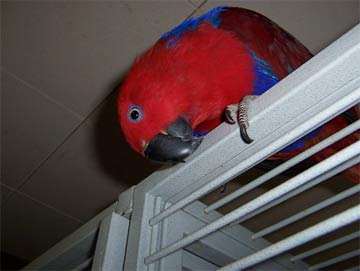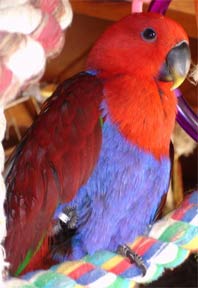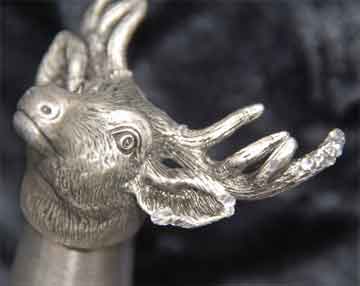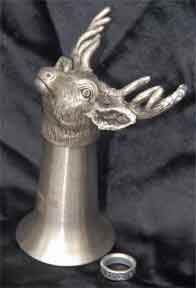 |
||
|
What is one of the worst fears for any aviculturist or bird owner? That of finding a supposedly healthy bird with no obvious signs of illness lying cold and still in the bottom of a cage. Whether it is a beloved pet, a valuable breeder, or perhaps both, the mind immediately wonders, ‘Is it an isolated event, or merely the tip of the iceberg?’ When my Solomon Island Eclectus hen, Isis was found dead in just these circumstances, I shipped her to the University of California Davis lab for a necropsy. Their reputation is excellent and I was confident that they would isolate the cause quickly. However, the necropsy and the histopathy returned with no clear cause of death. All the test results were negative. At this stage, at least, we knew what it was not. The doctor and I had been awaiting the results of one more test from Isis' necropsy and histopathology, and that was the one that found the cause. Isis died from acute lead poisoning. The vet called me as she was reading the lab results to tell me that although she and I had both been positive that the metal screening was an unnecessary test, she was so glad that I had requested that we should run it anyway. The lab manager brought the results over to her and the finding was 19.5 ppm. The allowable level is less than 5 ppm (parts per million). This indicated it was an acute case, meaning she had not been affected by the build up of gradual exposure in her system. There was a bad “something” in the bird room which she had gotten to, and unless we discovered exactly what it was, every other bird in there was at risk of being found on the bottom of the cage, in the exact same no warning manner. We discussed toys. I only use American made toys with stainless steel parts, and natural colored or vegetable food coloring. The bird’s cages are high quality, powder coated, name brand, safe cages. There were no draperies for her to extract a lead weight from. No blinds to get hardware off of. All shelving is high impact plastic or Formica. The room was a children's bedroom, already childproofed, for nearly 20 years before it became a bird room, so we were sure that paint and everything else about it were safe.
What could it be? What had we overlooked? What kind of deadly danger was still in that room? No metal at all had showed in any of the early tissue samples or slides of the necropsy. The vet, who I cannot say enough good things about, assured me that the parts must have been so minute that they passed with the first poop, but the damage was done.
Isis passed out and was probably unconscious shortly after I left for work, and never regained consciousness. She no doubt did not suffer, just felt ill, went to sleep, and woke up at the Bridge. She only picked at her dinner on Sunday evening, although she had eaten breakfast with her usual gusto, so whatever it was, we felt had been eaten on Sunday mid afternoon. After getting the horrible news of the necropsy, I hung up the phone and immediately made arrangements to take her mate, Solly, and the other birds in to the vet the next business day, for individual metal screens. I had not seen any of the green urates in their droppings that indicate metal poisoning, but I needed to be sure. Meanwhile, I fed unflavored Metamucil and a taste of peanut butter, which would help any particles that any of them might have had ingested, to pass.
My husband and I drove home from work fast and furiously, all the way discussing every item in the room, and which could have been the culprit. We decided that, as the afternoon sun shines into the room, we should hit the house, pull the cages out and start at the western end of the room, each taking half, and examine everything for beak marks or possible toxicity. It was not more than five minutes before I heard my husband Tom say, in a very sickened tone of voice, “I found it.” There was a very brief period of time, less than two months, where the bird room was used as a TV room by my husband and oldest son, previous to being commandeered by the birds. During that earlier time, a small color TV was placed on the top shelf of a high impact plastic shelving unit. The shelf space is now used for storage of bird food containers, to keep them off the floor. The TV was never removed, as it also has a VCR built in, which is handy for bird videos or children's shows, on those days when we might be away from home longer than usual. Because the unit is easily cleanable, we wipe it down and run the vacuum tool behind it, but don't move it out. That tiny bit of laziness proved fatal for Isis. This is what Tom had in his hand:
My sons gave their dad this little figural shot glass 10 years ago or so. Perhaps some night when they were watching TV, Tom carried it up there, used it to please them and set it down, intending to take it back downstairs, but forgot it. We will never know. We thought it was packed away or lost years ago. Isis had been nesty and prowled around on the bottom shelf, looking for a nice dark place, or perhaps a snack. Something of interest in the deep corner caught her eye. What could it be? A wonderful, shiny, beakable toy in a dark space! She tried to pull it out of the corner to play with it, but it was lodged in there and wouldn't budge. After a try or two, she gave up and came out to play on top of the cages, and to look out the window toward California, as she loved to do. Where was it, she wondered? After a while, she didn't feel too good and didn't really want her chicken, although she ate it to be polite to her unsuspecting mom. You know the rest. When Tom came up with what he had retrieved from the corner into the light, we could see the soft pewter antler had several fresh, shiny, obvious beak marks on it, as well as on the corresponding ear. There were only a few gashes, and no metal was missing, but the marks were unmistakable. We did a Google search and saw that the head was pewter. How could pewter, which was regulated some years ago, be the culprit? Because FIGURAL pewter, not intended to come into contact with eating surfaces, is mostly lead. The cup of the drinking implement is brushed stainless, but the head was deadly. A child could have picked it up and teethed on it, with the same results.
Isis carried only molecules on her beak, too small to be seen. Less than 24 hours later she was dead. Most of you do not have a bird room. Most of you keep your precious babies in your living spaces. The little wizards and dragons and figurines which you may have as knickknacks on your shelves, on your television, or in a shadow box on your wall, are all made of exactly the same stuff that killed Isis. The letter opener on your desk with the fancy handle has the same stuff. Please carefully and thoroughly look around your house today for anything like this. Please do not be like my husband and I, staring sadly at an empty cage, knowing if we had put something away in its proper place, or by taking the extra minutes to pull out a shelf, it would mean a living, beautiful, happy bird today.
|
||



